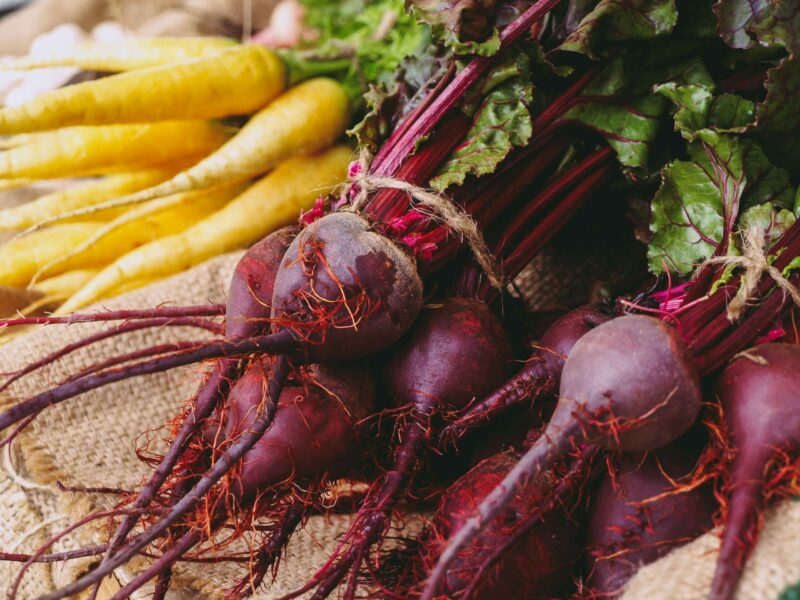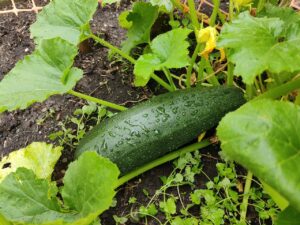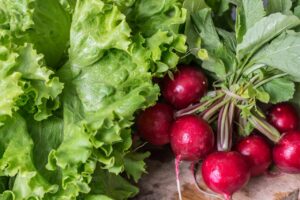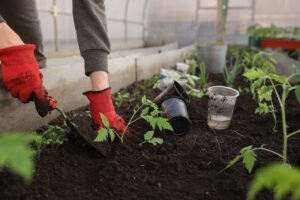The Comprehensive Guide to Growing Beets
Beets (Beta vulgaris) are versatile and nutritious root vegetables known for their earthy flavour and vibrant colours. From the deep red of the classic beet to the striking concentric rings of the Chioggia beet, there is a variety to suit every gardener’s taste. In this ultimate guide, we’ll explore how to grow beets, including tips on planting, care, and harvesting and an introduction to some popular beet varieties.
An Overview of Beet Varieties
Before planting beets in your garden, it’s essential to familiarize yourself with the different varieties available. Here are some popular options:
- Detroit Dark Red: A classic beet variety with deep red roots and a sweet, earthy flavour.
- Golden: This variety boasts bright yellow-orange roots and a milder, sweeter taste than its red counterparts.
- Chioggia: Also known as candy cane or bull’s eye beets, these heirloom beets feature pink and white concentric rings and a sweet, mild flavour.
- Cylindra: As the name suggests, this variety produces long, cylindrical roots that are perfect for slicing.
- Early Wonder: This early-maturing beet variety is known for its sweet taste and tender texture.
How to Grow Beets
Selecting the Perfect Site for Beet Planting
To ensure a bountiful harvest, it’s crucial to choose the right site for growing beets. Here are some factors to consider:
- Sunlight: Beets thrive in full sun, requiring at least six hours of direct sunlight daily. However, they can tolerate partial shade, especially in hotter climates.
- Soil: Beets prefer well-draining, fertile soil with a pH between 6.0 and 7.0. If your soil is clay-heavy or compacted, consider amending it with organic matter, such as compost or aged manure, to improve drainage and fertility.
- Space: Beets need ample space to grow, with at least 12 inches between rows and 2-4 inches between plants within a row.
Planting Beets in Your Garden
Follow these steps to plant beets successfully:
- Timing: Beets can be planted in early spring, as soon as the soil is workable, or in late summer for a fall harvest. In warmer climates, beets can be grown throughout the winter.
- Preparing the Soil: Remove any rocks, debris, and weeds from the planting area. Loosen the soil to a depth of 12 inches and incorporate organic matter if necessary.
- Planting the Seeds: Sow beet seeds directly into the prepared soil, spacing them 1/2 inch deep and 2 inches apart in rows 12 inches apart. Water the seeds gently to ensure good soil contact.
- Germination: Beet seeds typically germinate within 7-14 days, depending on soil temperature and moisture. Keep the soil consistently moist but not waterlogged during this period.
- Thinning: Once seedlings have grown to 2-3 inches tall, thin them to 4 inches apart to promote optimal root development.
Caring for Your Growing Beets
Proper care is key to a successful beet crop. Here are some tips for maintaining healthy beet plants:
- Watering: Beets require consistent moisture to grow well and prevent the roots from becoming tough or fibrous. Aim to provide 1-2 inches of water per week through rainfall or supplemental irrigation. Water the plants deeply and evenly, avoiding overhead watering, which can lead to leaf diseases.
- Mulching: Applying a 2-3 inch layer of organic mulch, such as straw or shredded leaves, around the beet plants can help conserve moisture, suppress weeds, and regulate soil temperature. Be sure to keep the mulch a few inches away from the base of the plants to prevent rot.
- Fertilizing: Beets benefit from a balanced, slow-release fertilizer, which should be applied according to package instructions. Alternatively, you can side-dress the plants with compost or aged manure during the growing season. Be cautious not to over-fertilize, as excessive nitrogen can lead to abundant leaf growth at the expense of root development.
- Weed Control: Keep the beet planting area free of weeds, which compete with the plants for nutrients and water. Hand-pulling or shallow cultivation is recommended to avoid damaging the developing beet roots.
- Pest Management: Beets may be affected by pests such as leaf miners, aphids, and flea beetles. Regularly inspect your plants for signs of infestation and address any issues promptly. Employing integrated pest management (IPM) strategies, like using row covers or introducing beneficial insects, can help reduce reliance on chemical controls.
Harvesting and Storing Your Beets
Knowing when and how to harvest beets is crucial for enjoying their peak flavour and texture. Follow these guidelines for a successful harvest:
- Harvesting Time: Beets can be harvested when their roots reach the desired size, typically 2-3 inches in diameter for most varieties. However, they can be harvested smaller for tender baby beets or left to grow larger for processing. Keep in mind that larger beets may become fibrous or lose flavour.
- Harvesting Technique: To harvest beets, gently loosen the soil around the root with a garden fork, taking care not to damage the root or nearby plants. Grasp the beet greens firmly and pull the root from the ground.
- Greens: Don’t forget about the beet greens! They are a nutritious and delicious addition to salads, sautés, and other dishes. Harvest greens when they are young and tender, around 4-6 inches tall.
- Storage: Beets can be stored for several weeks or even months if kept in the right conditions. Remove the leaves, leaving about 1 inch of stem attached to the root. Clean the beets and allow them to dry before storing them in a cool, dark place, such as a root cellar or refrigerator. Wrap each beet in a damp paper towel and place them in a perforated plastic bag to maintain humidity.
Common Beet Problems and Solutions
Even the most diligent gardener may encounter issues when growing beets. Here are some common problems and their solutions:
- Cracked or Misshapen Roots: This can be caused by uneven watering, nutrient imbalances, or soil compaction. Ensure consistent moisture, amend soil as necessary, and avoid walking on planting beds to prevent soil compaction.
- Leaf Yellowing or Wilting: This may indicate a nutrient deficiency, overwatering, or disease. Test your soil and adjust fertilization accordingly, monitor watering to avoid over-saturation, and promptly address any signs of disease.
- Slow Growth or Small Roots: Factors that can contribute to slow growth or small roots include insufficient sunlight, overcrowding, or poor soil fertility. Make sure your beets receive adequate sunlight, thin seedlings properly, and amend the soil with organic matter to improve fertility.
Companion Planting for Beets: Boosting Growth & Flavor in Your Garden
Companion planting is an age-old gardening technique that involves growing different plants together to enhance their growth, productivity, and flavour. When it comes to beets (Beta vulgaris), companion planting can offer several benefits, such as pest control, soil improvement, and increased yield. In this detailed guide, we will explore the best companion plants for beets and provide tips for creating a thriving and harmonious garden.
The Benefits of Companion Planting for Beets
- Pest control: Some companion plants can help deter pests that are harmful to beets, reducing the need for chemical interventions.
- Soil improvement: Certain plants can improve soil fertility, making it more conducive to beet growth.
- Enhanced growth and yield: Some companions can boost beet growth and yield by attracting beneficial insects, providing shade, or improving soil structure.
- Flavour enhancement: Growing specific plants together can result in improved flavour and quality of the beets.
The Best Companion Plants for Beets
Here is a list of plants that make ideal companions for beets and the benefits they offer:
- Onions, Garlic, and Shallots: These allium family members help deter pests such as aphids, flea beetles, and leaf miners, which can cause damage to beet plants.
- Lettuce: As a shallow-rooted plant, lettuce makes an excellent companion for beets, as it does not compete for soil nutrients. Additionally, lettuce can provide shade for beet plants in hot weather, helping to keep the soil cool and moist.
- Brassicas (Cabbage, Broccoli, Cauliflower, etc.): These plants can help deter root maggots, which can damage beet roots.
- Beans and Peas: As legumes, beans and peas can fix nitrogen in the soil, improving fertility and supporting healthy beet growth.
- Radishes: Planting radishes among your beets can help deter pests like flea beetles and also act as a trap crop for leaf miners, drawing them away from your beets.
- Dill: This herb can attract beneficial insects, such as ladybugs and lacewings, which prey on aphids and other pests that can harm beets.
- Marigolds: These colourful flowers can repel nematodes, which can damage beet roots. Marigolds also attract beneficial insects that help control pests.
Plants to Avoid Planting Near Beets
While many plants make excellent companions for beets, there are some that should be kept at a distance. These plants may compete for resources or negatively impact beet growth:
- Pole Beans: Pole beans can stunt beet growth due to the competition for nutrients and root space. Stick to bush beans or peas as legume companions instead.
- Mustard Greens: Mustard greens can attract pests that also target beets, such as flea beetles, so it is best to keep these plants separate.
- Potatoes: Beets and potatoes are both susceptible to the same fungal diseases, so planting them together can increase the risk of infection.
Tips for Successful Companion Planting with Beets
- Plan ahead: Sketch out your garden layout before planting, considering the growth habits and needs of each plant. This will help ensure proper spacing and compatibility.
- Rotate crops: Rotate your beets and their companions every year to prevent the buildup of pests and diseases in the soil and to maintain soil fertility.
- Intercropping: Instead of planting your beets and companion plants in separate rows, consider intercropping or mixing the plants within the same row. This can help create a diverse and harmonious growing environment that benefits all plants involved.
- Observe and adjust: Keep an eye on your garden throughout the growing season and make note of any positive or negative interactions between plants. Adjust your planting plan as needed based on your observations.
- Balance sun and shade: Be mindful of the sunlight requirements of your beets and their companions. Ensure that taller plants do not block sunlight from reaching your beets, which require at least six hours of direct sunlight per day.
- Consider plant diversity: Including a variety of companion plants in your garden can help attract a wider range of beneficial insects, improve soil health, and create a more resilient growing environment.
Companion planting for beets can offer numerous benefits, from pest control and soil improvement to enhanced growth, yield, and flavor. By choosing compatible plants, such as onions, lettuce, brassicas, beans, peas, radishes, dill, and marigolds, you can create a thriving and harmonious garden that maximizes productivity and taste. Just as importantly, avoid planting beets near pole beans, mustard greens, and potatoes, which can hinder their growth or increase the risk of disease. By following these guidelines and tips, you’ll be well on your way to a bountiful beet harvest and a beautiful, diverse garden.
Using Beets in the Kitchen
Once you’ve successfully grown and harvested your beets, it’s time to enjoy their flavours in various culinary applications. Here are some ideas to get you started:
- Salads: Roasted or raw, sliced beets make a delicious and colourful addition to salads. Pair them with goat cheese, toasted nuts, and a simple vinaigrette for a satisfying dish.
- Soups: Beets can be used to create hearty, comforting soups, such as the classic Eastern European borscht.
- Side Dishes: Roasted beets can be tossed with olive oil, salt, and pepper for a simple yet flavorful side dish. For an extra burst of flavour, try adding fresh herbs, balsamic vinegar, or citrus zest.
- Pickles: Pickled beets are a tangy, sweet treat that can be used as a condiment or enjoyed on their own. Experiment with different pickling spices and vinegars to create your signature blend.
- Smoothies and Juices: Beets are packed with nutrients, making them a healthy addition to smoothies and fresh juices. Their natural sweetness pairs well with fruits like berries and oranges, while their earthy flavour complements greens like kale and spinach.
Conclusion
Learning how to grow beets can greatly enrich your gardening journey and enhance your culinary repertoire. By choosing the ideal variety, planting in suitable conditions, and diligently tending to your beet plants, you’ll be well on your way to a bountiful harvest. Don’t hesitate to explore various recipes and cooking methods to appreciate your homegrown beets’ potential fully. Embrace the experience and relish the fruits of your labour. Happy gardening!




